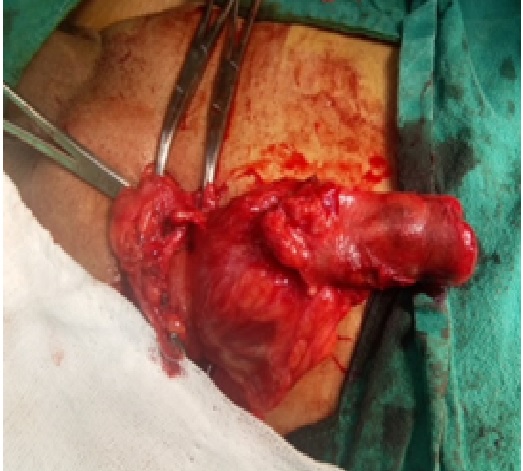Incarcerated sigmoid colon with gangrenous appendices epiploicae:A rare case report
Keywords:
Incarcerated Inguinal Hernia left side, Sigmoid colon, Appendices epiploicae
Abstract
Incarcerated inguinal hernia is a common diagnosis in patients presenting with a painful and not reducible groin mass. Sliding hernias are supposed to be more anatomically challenging for a surgeon than an uncomplicated inguinal hernias. The anatomical and physiological concept of sliding inguinal hernia is frequently misunderstood by surgeons of all levels of experience. Except in sliding hernia, the sigmoid colon is uncommonly found in an inguinal hernia.
Downloads
Download data is not yet available.
References
1. Malangoni MA, Rosen MJ.Hernias In: Townsend CM, Beauchamp RD, Evers BM, Mattox KL (Eds.). Sabiston textbook of surgery, Saunders Elsevier, Philadelphia 2008; 18:1155-1179.
2. Tufnell ML, Abraham-Igwe C. A perforated diverticulum of the sigmoid colon found within a strangulated inguinal hernia. Hernia. 2008 Aug;12(4):421-3. Epub 2007 Nov 15.DOI: 10.1007/s10029-007-0308-2.
3. De Vesalius A. Humanis corporis fabricia libri septem..In:Basileae, ed. Andreaevesaliibruxellensis, schloaemedicorumpatauiniaeprofessoris de humani corporis fabricialibriiseptem. Basel, Switzerland: Ex officinaJoannisOporini; 1543-4.
4. Abdulzhavadov IM. Volvulus of the epiploic appendices of the sigmoid in strangulated inguinal hernia. Klin Med (Mosk). 1989 Jan;67(1):126-7.
5. Kulacoglu H, Tumer H, Aktimur R, Kusdemir A. Epiploic appendicitis in inguinal hernia sac presenting an inguinal mass. DOI:10.1007/s10029-004-0306-6.[pubmed]
6. ScarpaA.Sull’ernie: memorieanatomo-chirurgiche. Milan: StamperiaReale, 1809,1820.
7. RYAN EA. An analysis of 313 consecutive cases of indirect sliding inguinal hernias. SurgGynecol Obstet. 1956 Jan;102(1):45-58.[pubmed]
8. McFadyen BV Jr, Mathis CR.Inguinal herniorrhaphy: complications and recurrences.SeminLaparoscSurg 1994; 1:128-40.DOI:10.1053/SLAS00100128
9. Gallegos NC, Dawson J, Jarvis M, Hobsley M. Risk of strangulation in groin hernias. Br J Surg. 1991 Oct;78(10):1171-3.[pubmed]
10. Bastidas JG, Danzy LE, Blackwell L, et al. Epiploic appendicitis in a 24-year-old woman. DOI:10.1016/j.ajem.2008.01.033
11. Jain M, Khanna S, Sen B, Tantia O. J Minim Access Surg. 2008 Jul;4(3):85-7.[pubmed]
12. Klingenstein P. Some phases of the pathology of the appendices epipoicae. Surggynecol obstet. 1924; 38:376-383.[pubmed]
13. Ozkurt H, Karatağ O, Karaarslan E, Başak M. Clinical and CT findings of epiploic appenda gitis within an inguinal hernia. Diagn IntervRadiol. 2007 Mar;13(1):23-5.[pubmed]
14. Bendavid R. Sliding hernias. DOI:10.1007/s10029-002-0065-1.[pubmed]
2. Tufnell ML, Abraham-Igwe C. A perforated diverticulum of the sigmoid colon found within a strangulated inguinal hernia. Hernia. 2008 Aug;12(4):421-3. Epub 2007 Nov 15.DOI: 10.1007/s10029-007-0308-2.
3. De Vesalius A. Humanis corporis fabricia libri septem..In:Basileae, ed. Andreaevesaliibruxellensis, schloaemedicorumpatauiniaeprofessoris de humani corporis fabricialibriiseptem. Basel, Switzerland: Ex officinaJoannisOporini; 1543-4.
4. Abdulzhavadov IM. Volvulus of the epiploic appendices of the sigmoid in strangulated inguinal hernia. Klin Med (Mosk). 1989 Jan;67(1):126-7.
5. Kulacoglu H, Tumer H, Aktimur R, Kusdemir A. Epiploic appendicitis in inguinal hernia sac presenting an inguinal mass. DOI:10.1007/s10029-004-0306-6.[pubmed]
6. ScarpaA.Sull’ernie: memorieanatomo-chirurgiche. Milan: StamperiaReale, 1809,1820.
7. RYAN EA. An analysis of 313 consecutive cases of indirect sliding inguinal hernias. SurgGynecol Obstet. 1956 Jan;102(1):45-58.[pubmed]
8. McFadyen BV Jr, Mathis CR.Inguinal herniorrhaphy: complications and recurrences.SeminLaparoscSurg 1994; 1:128-40.DOI:10.1053/SLAS00100128
9. Gallegos NC, Dawson J, Jarvis M, Hobsley M. Risk of strangulation in groin hernias. Br J Surg. 1991 Oct;78(10):1171-3.[pubmed]
10. Bastidas JG, Danzy LE, Blackwell L, et al. Epiploic appendicitis in a 24-year-old woman. DOI:10.1016/j.ajem.2008.01.033
11. Jain M, Khanna S, Sen B, Tantia O. J Minim Access Surg. 2008 Jul;4(3):85-7.[pubmed]
12. Klingenstein P. Some phases of the pathology of the appendices epipoicae. Surggynecol obstet. 1924; 38:376-383.[pubmed]
13. Ozkurt H, Karatağ O, Karaarslan E, Başak M. Clinical and CT findings of epiploic appenda gitis within an inguinal hernia. Diagn IntervRadiol. 2007 Mar;13(1):23-5.[pubmed]
14. Bendavid R. Sliding hernias. DOI:10.1007/s10029-002-0065-1.[pubmed]

CITATION
DOI: 10.17511/ijoso.2018.i02.05
Published: 2018-06-30
How to Cite
Gaurav, W., & K.C., V. (2018). Incarcerated sigmoid colon with gangrenous appendices epiploicae:A rare case report. Surgical Review: International Journal of Surgery, Trauma and Orthopedics, 4(2), 87-89. https://doi.org/10.17511/ijoso.2018.i02.05
Section
Case Report
Copyright (c) 2018 Author (s). Published by Siddharth Health Research and Social Welfare Society

This work is licensed under a Creative Commons Attribution 4.0 International License.


 OAI - Open Archives Initiative
OAI - Open Archives Initiative


















 Therapoid
Therapoid

